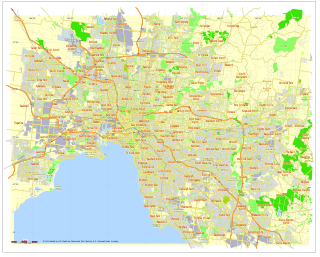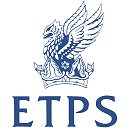
No. 3 Squadron is a Royal Australian Air Force (RAAF) fighter squadron, headquartered at RAAF Base Williamtown, near Newcastle, New South Wales. Established in 1916, it was one of four combat squadrons of the Australian Flying Corps during World War I, and operated on the Western Front in France before being disbanded in 1919. It was re-raised as a permanent squadron of the RAAF in 1925, and during World War II operated in the Mediterranean Theatre. The Cold War years saw the squadron disbanded and re-raised twice. It was based at RAAF Butterworth during the Malayan Emergency and the Indonesia–Malaysia Konfrontasi. Equipped with McDonnell Douglas F/A-18 Hornet multi-role fighters from 1986, the squadron deployed to Diego Garcia in 2002 to provide local air defence, and the following year contributed aircraft and crews to the invasion of Iraq as part of Operation Falconer. In April 2016, it deployed to the Middle East as part of the military intervention against ISIL.

No. 79 Squadron is a Royal Australian Air Force (RAAF) flight training unit that has been formed on four occasions since 1943. The squadron was established in May 1943 as a fighter unit equipped with Supermarine Spitfires, and subsequently saw combat in the South West Pacific theatre of World War II. Between June 1943 and the end of the war in August 1945 it flew air defence patrols to protect Allied bases and ships, escorted Australian and United States aircraft, and attacked Japanese positions. The squadron was disbanded in November 1945, but was re-formed between 1962 and 1968 to operate CAC Sabres from Ubon Air Base in Thailand. In this role it contributed to the defence of Thailand against a feared attack from its neighbouring states and exercised with United States Air Force units. No. 79 Squadron was active again at RAAF Base Butterworth in Malaysia between 1986 and 1988 where it operated Mirage III fighters and a single DHC-4 Caribou transport during the period in which the RAAF's fighter squadrons were transitioning to new aircraft.
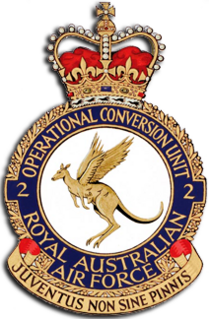
No. 2 Operational Conversion Unit is a fighter training unit of the Royal Australian Air Force (RAAF). Located at RAAF Base Williamtown, New South Wales, the unit trains pilots to operate the McDonnell Douglas F/A-18 Hornet, conducts refresher courses for pilots returning to the type, and trains future Hornet instructors. Pilots new to the Hornet enter No. 2 OCU after first qualifying to fly fast jets at No. 79 Squadron and undertaking initial fighter combat instruction at No. 76 Squadron. Once qualified on the F/A-18, they are posted to one of No. 81 Wing's operational Hornet units, No. 3 Squadron, No. 75 Squadron or No. 77 Squadron.

Central Flying School (CFS) is a Royal Australian Air Force (RAAF) training unit, located at RAAF Base East Sale, Victoria. It operates the Pilatus PC-9 turboprop trainer. The school is responsible for training flight instructors, setting flying standards, and auditing flying practices. It is also home to the "Roulettes" aerobatic team. CFS was the first military aviation unit to be formed in Australia, in 1913, when its role was to provide basic flying training. Its current form dates from World War II, when it was re-established to train flying instructors for the Empire Air Training Scheme (EATS).

Air Chief Marshal Sir Frederick Rudolph William Scherger, was a senior commander in the Royal Australian Air Force (RAAF). He served as Chief of the Air Staff, the RAAF's highest-ranking position, from 1957 until 1961, and as Chairman of the Chiefs of Staff Committee, forerunner of the role of Australia's Chief of the Defence Force, from 1961 until 1966. He was the first RAAF officer to hold the rank of air chief marshal.
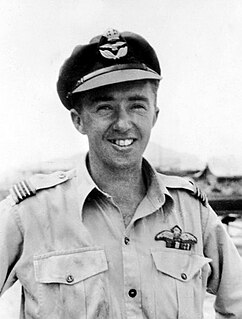
Air Chief Marshal Sir Neville Patrick McNamara, was a senior commander of the Royal Australian Air Force (RAAF). He served as Chief of the Air Staff (CAS), the RAAF's highest-ranking position, from 1979 until 1982, and as Chief of the Defence Force Staff (CDFS), Australia's top military role at the time, from 1982 until 1984. He was the second RAAF officer to hold the rank of air chief marshal.

No. 5 Operational Training Unit was an operational training unit (OTU) of the Royal Australian Air Force. It was formed at Wagga Wagga, New South Wales, in October 1942 to train pilots and navigators for service in World War II. The unit was initially equipped with Bristol Beauforts and Beaufighters, and later received Douglas Bostons and de Havilland Mosquitos, among other types. No. 5 OTU was transferred to Tocumwal in October 1943, and then to Williamtown in mid-1944. It was reorganised as a fighter conversion unit flying P-51 Mustangs and CAC Wirraways in February 1946, and disbanded in July 1947.

Air Marshal Sir John Patrick Joseph McCauley, KBE, CB was a senior commander in the Royal Australian Air Force (RAAF). He served as Chief of the Air Staff from 1954 to 1957. A Duntroon graduate, McCauley spent four years in the Australian Military Forces before transferring to the RAAF in 1924. He was Director of Training from 1936 to 1938, and commanded engineering and flying training schools for the first eighteen months of World War II. Having been promoted to group captain in 1940, he was posted to Singapore in June 1941 to take charge of all RAAF units defending the area. He earned praise for his efforts in attacking invading Japanese forces before the fall of Singapore, and for his dedication in evacuating his men. After serving as Deputy Chief of the Air Staff in 1942–44, he was appointed to a senior operational role with the Royal Air Force's 2nd Tactical Air Force in Europe, where he saw out the rest of the war.
Air Vice Marshal Alfred John Quaife, AM is a retired senior officer of the Royal Australian Air Force (RAAF).

Air Marshal Sir Charles Frederick Read, KBE, CB, DFC, AFC was a senior commander in the Royal Australian Air Force (RAAF). He served as Chief of the Air Staff (CAS) from 1972 to 1975. Born in Sydney, Read joined the RAAF in 1937, and began his career flying biplane fighters. As a Beaufighter pilot, he led No. 31 Squadron and No. 77 Wing in the South West Pacific during World War II. His achievements earned him the Distinguished Flying Cross and a mention in despatches, and he finished the war an acting group captain.

Air Marshal Sir Alister Murray Murdoch, was a senior commander in the Royal Australian Air Force (RAAF). He served as Chief of the Air Staff (CAS) from 1965 to 1969. Joining the Air Force in 1930, Murdoch trained as a seaplane pilot, and participated in an Antarctic rescue mission for lost explorers in 1935. During World War II, he commanded No. 221 Squadron RAF in Europe and the Middle East, and later occupied senior positions on the staff of RAAF formations in the South West Pacific. His post-war appointments included Commandant of RAAF College from 1952 to 1953, Air Officer Commanding (AOC) Training Command from 1953 to 1955, Deputy Chief of the Air Staff from 1958 to 1959, and AOC Operational Command from 1962 to 1965.
Air Marshal Shah Mohammad Ziaur Rahman, ndc, fawc, psc was Chief of Staff of the Bangladesh Air Force. He was preceded by Air Vice Marshal Fakhrul Azam, ndc, psc.

Air Vice Marshal Francis Masson (Frank) Bladin, was a senior commander in the Royal Australian Air Force (RAAF). Born in rural Victoria, he graduated from the Royal Military College, Duntroon, in 1920. Bladin transferred from the Army to the Air Force in 1923, and learned to fly at RAAF Point Cook, Victoria. He held training appointments before taking command of No. 1 Squadron in 1934. Quiet but authoritative, he was nicknamed "Dad" in tribute to the concern he displayed for the welfare of his personnel.

Air Marshal John William "Jake" Newham, AC is a retired senior commander of the Royal Australian Air Force (RAAF). He served as Chief of the Air Staff (CAS) from 1985 until 1987. Joining the RAAF in 1951, he flew Gloster Meteor jets with No. 77 Squadron in the Korean War in 1953, and subsequently de Havilland Vampires with No. 78 Wing on garrison duty in Malta. From 1958 to 1960, he served with No. 3 Squadron, operating CAC Sabres during the Malayan Emergency. He took charge of No. 3 Squadron in 1967, when it re-equipped with the Dassault Mirage III supersonic fighter. His commands in the early 1970s included the Aircraft Research and Development Unit, RAAF Base Laverton, and No. 82 Wing, the last-mentioned during its first years operating the long-delayed General Dynamics F-111C swing-wing bomber. He was appointed Deputy Chief of the Air Staff in March 1984, and CAS in May the following year. His tenure as CAS coincided with the release of the Dibb Report on Australia's defence capabilities, and the controversial transfer of the RAAF's battlefield helicopters to the Australian Army. Newham retired from the Air Force in July 1987 and became a company director.

Air Vice Marshal Ian Dougald McLachlan, CB, CBE, DFC was a senior commander in the Royal Australian Air Force (RAAF). Born in Melbourne, he was a cadet at the Royal Military College, Duntroon, before joining the Air Force in December 1930. After serving in instructional and general flying roles, he took command of No. 3 Squadron in December 1939, leading it into action in the Middle East less than a year later. Awarded the Distinguished Flying Cross, he returned to Australia in 1942 to command air bases in Canberra and Melbourne. The following year he was posted to the South West Pacific, where he led successively Nos. 71 and 73 Wings. Having been promoted to group captain, he took charge of Southern Area Command in 1944, and No. 81 Wing in the Dutch East Indies the following year.
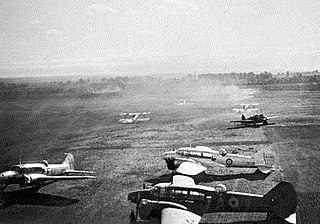
No. 2 Service Flying Training School was a flying training school of the Royal Australian Air Force (RAAF) that operated during World War II. It was formed in July 1940, under the command of Wing Commander Frederick Scherger. Responsible for intermediate and advanced instruction of pilots under the Empire Air Training Scheme (EATS), the school was based at RAAF Station Forest Hill near Wagga Wagga, New South Wales, and operated CAC Wirraway and Avro Anson aircraft. The Ansons were phased out in July 1941, and the school became an all-Wirraway unit. In 1942 the RAAF divided the personnel and equipment of No. 2 SFTS between Nos. 5 and 7 Service Flying Training Schools at Uranquinty and Deniliquin, respectively. No. 2 SFTS was disbanded that April, and the base facilities taken over by No. 5 Aircraft Depot.

Air Vice Marshal Frank Headlam, was a senior commander in the Royal Australian Air Force (RAAF). Born and educated in Tasmania, he joined the RAAF as an air cadet in January 1934. He specialised in flying instruction and navigation before the outbreak of World War II. In April 1941, he became commanding officer of No. 2 Squadron, which operated Lockheed Hudsons. The squadron was deployed to Dutch Timor in December, and saw action against Japanese forces in the South West Pacific. After returning to Australia in February 1942, Headlam held staff appointments and training commands, finishing the war a group captain.

Air Marshal Gavin Neil "Leo" Davies, is a retired senior officer of the Royal Australian Air Force (RAAF). A navigator who retrained as a pilot, he joined the RAAF in 1979, commanded No. 1 Squadron RAAF (2002–03) and No. 82 Wing RAAF (2004–05), deployed to Iraq in 2007, and was Australia's air attaché in Washington, D.C. (2010–11). He served as Deputy Chief of Air Force from 2012 to 2015 and succeeded Air Marshal Geoff Brown as Chief of Air Force, the professional head of the RAAF, in July 2015. He retired from the RAAF in July 2019.
Air Vice Marshal Gavin Alexander Turnbull, is a retired senior commander in the Royal Australian Air Force (RAAF). He joined the RAAF in 1984, trained as a helicopter pilot, and transferred to fast jets in 1991. He has commanded No. 77 Squadron RAAF (2002–04), No. 81 Wing RAAF (2007–11) and the 609th Combined Air Operations Centre (2012), and deployed on operations to the Sinai Peninsula, Iraq and Afghanistan. He served as Air Commander Australia from 2014 to 2017, and Deputy Chief of Air Force from May 2017 to July 2019.



